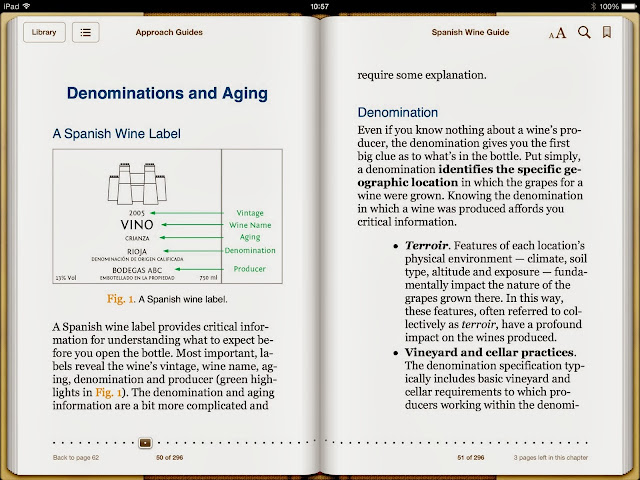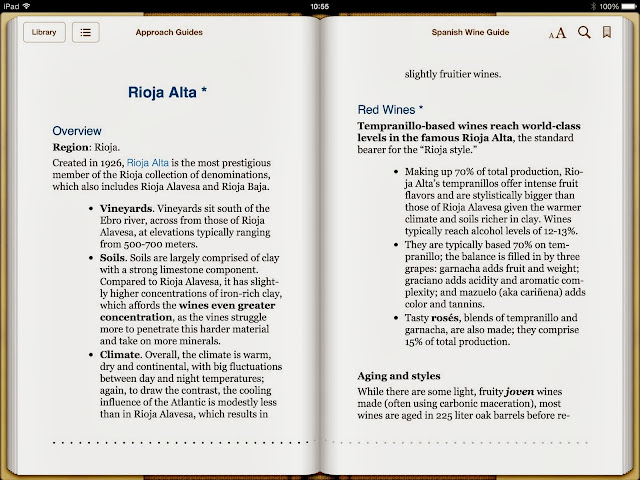If you’re a wine lover and want to savor Spain’s wine regions, Jennifer and David Raezer’s Spanish Wine Guide is for you. The state-of-the-art guidebook is one of more than 35 food, wine, and travel Approach Guides researched, written and published by the Raezers.
In the Spanish Wine Guide, they provide a wealth of information about Spain’s vast wine regions. From Catalunya’s sparkling Cava region to the world famous Rioja wine region, this 174-page guide has it all.

I felt a bit of nostalgia as I journeyed with the Raezers through the country’s 17 autonomous regions. Spain boasts 69 denominacion de origen or denomination of origin (DO) wine regions. The wine guide covers many of the well-known regions and some up-and-comers.
Detailed information will please anyone interested in learning about Spanish wine. The guide begins with terroir or the location where the wine is grown. A description of soil and climate follows. The next basic fact highlighted is the primary grapes grown in the appellation.

“While we have visited most of Spain’s wine producing regions, we have not visited all of the individual denominations. You will see that our profiles for this guidebook mirror the protocol for all our wine guidebooks,” said David Raezer.
The guides were an outgrowth of personal travel notes taken when the Raezers found facts missing from other, more traditional guidebooks. That’s when the New York couple chose to marry their love of wine, food, and travel and create digital Approach Guides focusing on all three loves.
“Our guidebooks are for the ultra-curious, profiling a signature collection of sites that reveal a destination’s cultural essence. They enable curious travelers to engage more deeply with our global cultural heritage,” Jennifer Raezer stated in a recent interview.
This dynamic duo has not only lived and traveled all over the world but publishes a diverse collection of intellectually challenging guidebooks. Some of their guidebooks focus on ancient Petra in Jordan, Maya Ruins in Mexico, Delhi and Agra in India, and even Foods from Italy.
The downloadable guidebooks are easy to read, well organized and, best of all, work with high tech electronic devices such as iPhones and iPads. Now, travelers with a thirst for Spanish wines or a scholar’s interest in world-renowned sites can skip buying the traditional guidebook.
Speaking from personal experience as a wine journalist, I no longer have to pack a reporter’s notebook when gathering information to write about specific wine region. Nor do I have to depend on a Half-Priced Books guide purchase or a tour guide’s narrative when visiting a wine region.
The Approach Guides work even better than Google because information is synthesized. The Spanish Wine Guide was like having a cheat-sheet for a Court of Master Sommeliers exam and a copy of Wine Spectator rolled into one.

“Our denomination profiles are born out of what is now a multi-year project to profile the major wine-producing areas in the world. The content that is now in the book was first published in a wine app we released in 2009,” David added.
The Raezers have painstakingly plotted and traced each wine denomination’s history, grape variety, terroir, and specialty. Having visited Rioja Alavesa in the Basque region and Rias Baixas in the Galicia region, I can attest to the need for a tool like the “e-centered” wine approach guide.
The wine guide is a strategically organized framework and context that makes it easy to navigate. Some information, such as wine recommendations by the authors, is in bold text while important basic information is highlighted.
As a lifelong “Spainophile” and wine enthusiast, I loved the Spanish Wine Guide for several reasons: links to the various wine regions, a wine map published by Wines from Spain (Spanish wine guide created by the Institute for Foreign Trade) (ICEX), and an illustration of a Spanish wine label.
Aged Spanish wines are classified as Crianza, Reserva, and Gran Reserva. But I’m sure wine novices have wondered about the meaning of the terms listed on a bottle of Spanish wine. So the label illustration includes the name of the wine, the vintage, age classification, denomination, and producer.
That said, the in-depth coverage of Spain’s wine regions is exceptional. In fact, I learned about regions I didn’t even know existed. And while there are a slew of wine guides, this one is one of the best.
The Raezers also update Approach Guides continuously via today’s electronic devices. Their website invites buyers of their guidebooks to sign up to receive regular updates. Now that’s what I call progress!
With 62 worldwide destinations published thus far, it’s clear that this jet-setting couple has started a trend that will see the demise of traditional guidebooks. And I think that’s a good thing. Approach Guides are priced from $4.99 to $7.99 at www.amazon.com.
More information: www.approachguides.com Contact: info[at]approachguides.com
